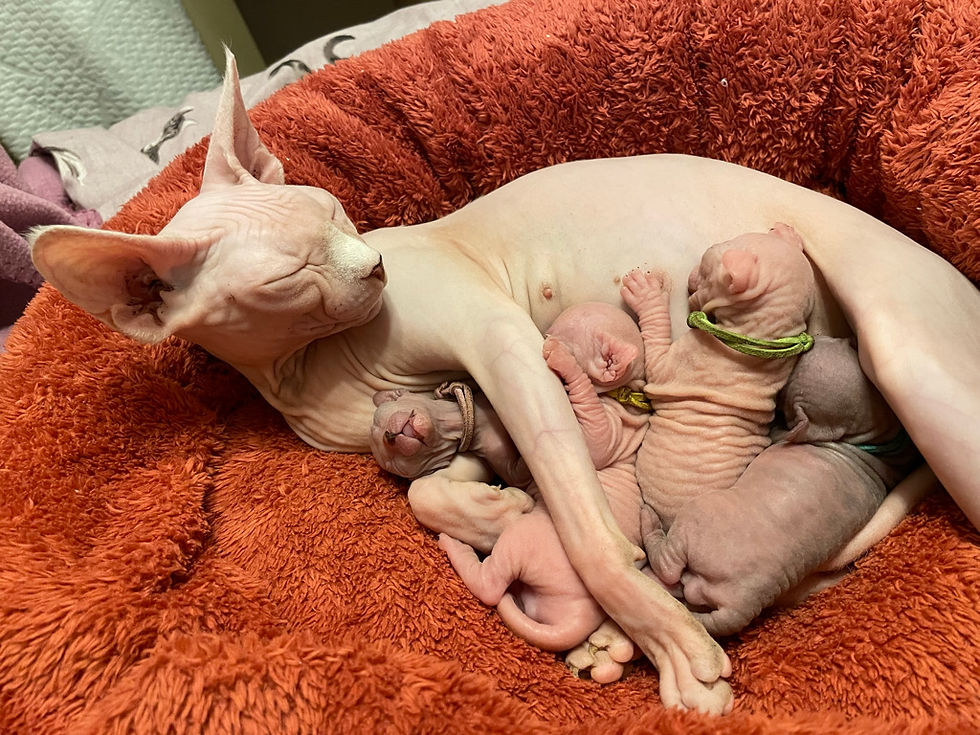Sphynx
- karenebrooks
- Nov 9, 2019
- 3 min read
Updated: Aug 22, 2020

The most obvious feature of the Sphynx cat is its lack of fur. They are not entirely hairless though, having a covering of fine down, giving them a soft feel, often described as like a hot peach. (Cats have higher normal body temperatures than humans, but this not obvious when touching their fur like it is when touching a Sphynx.) A Sphynx should have a wedge shaped head with deep set, lemon-shaped eyes. They are fine-boned but muscular cats with slender legs, and a long, tapered tail. Kittens are covered in wrinkles but the skin becomes more taut as the cat matures. The above is a picture of our Sphynx queen, Kika, who is white, but pigmentation is clearly visible on the skin with all patterns and colours acceptable. Contrary to popular opinion, they are not hypoallergenic, having the same allergens in their saliva as most of their furry cousins, but many people who suffer allergies find the Sphynx easier to live with than other non-hypoallergenic cats
The main feature of living with a Sphynx is just how highly active and inquisitive they are. They are also extremely mischievous and incredibly sociable. They like people, and will be in your face all the time. They thrive on attention and are intelligent in their efforts to obtain it. They are playful and can be talkative, they also like to purr a lot. They enjoy company, including that of children and other animals, and make a wonderful addition to any family that is prepared to lavish the time and attention they crave. They are so needy of companionship though that they cannot really be kept as an only pet - ideally they should have other feline company, they will particularly like another Sphynx. As much as their general disposition, they are very cuddly because they like any source of warmth and they do like to sleep with their owners, usually under the covers, so act like hot water bottles, even in the summer. Because of their lack of fur, they are at risk of getting too cold, but also of sunburn, so they are an indoor breed. Supervised outdoor time may be something they enjoy, but they have little protection against the elements and may need clothes or suncream (this has to be pet suitable not the human lotions) and should never be allowed to free roam. Most Sphynx do not generally need clothes, extra blankets around and in their beds are generally sufficient. As with all cats, Sphynx cats benefit from protection against disease through vaccination and need annual veterinary health checks. They should also be treated for fleas and worms. Like Ragdolls, they are prone to juvenile Hypertrophic Cardiomyopathy (HCM), but unlike Ragdolls, no gene has yet been identified that predicts this. Sphynx cats used in any breeding programmes should therefore be screened annually for signs of HCM by ultrasonography. Every cat is unique and each has their own particular likes, dislikes, and needs when it comes to food. However, cats are carnivores and every cat must obtain 41 different and specific nutrients from their food. The proportion of these nutrients will vary depending on age, lifestyle and overall health, so it's not surprising that a growing, energetic kitten needs a different balance of nutrients in her diet than a less active senior cat. Sphynx cats will need between 15-30% more food than breeds with fur as they use more energy to maintain body temperature. In general, a cat should have ribs that are not easy to see but are easy to feel. Any changes to diet should be introduced over days to weeks, gradually increasing the amount of the new food to avoid any digestive upsets. Contrary to what might be expected, Sphynx cats need quite a lot of attention to grooming. Owners must pay meticulous attention to keeping the Sphynx cat's skin clean and supple. The skin needs to be bathed or sponged to remove its oily secretions, however, these can be worse after bathing so doing so too often can make the problem worse. The brown oil can show up very obviously on pale materials, though happily it washes out quite easily too. Because of the lack of hair, ear secretions also build up and need regular cleaning to prevent ear infections. The oil also collects on the claws and skin folds around the toes which can be stubborn to remove.




コメント